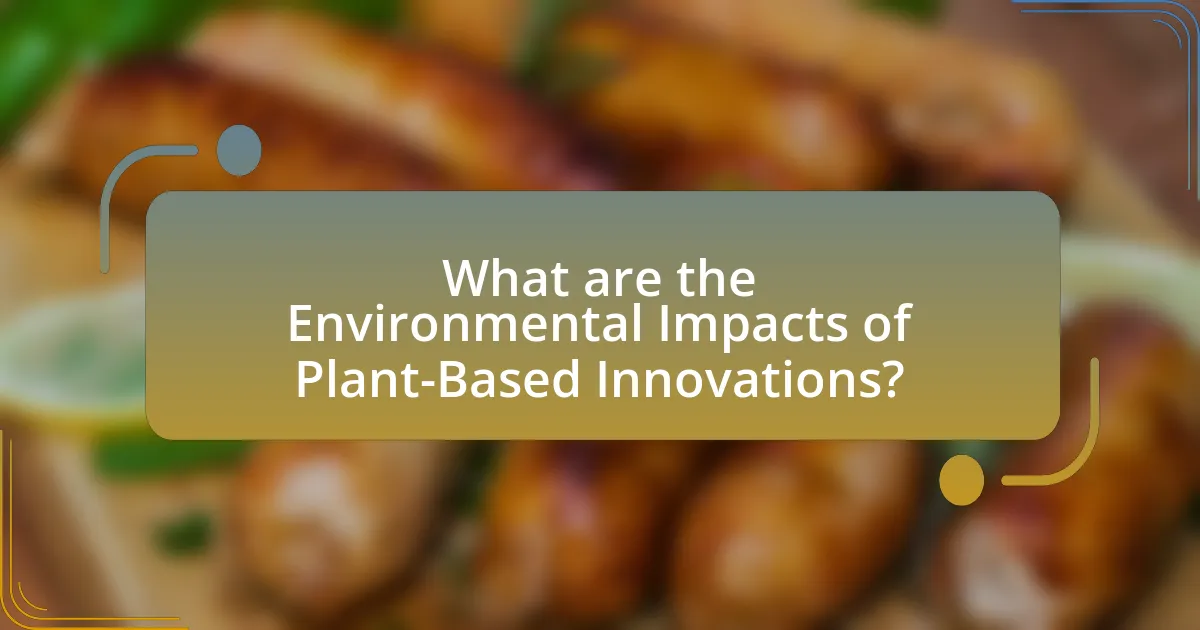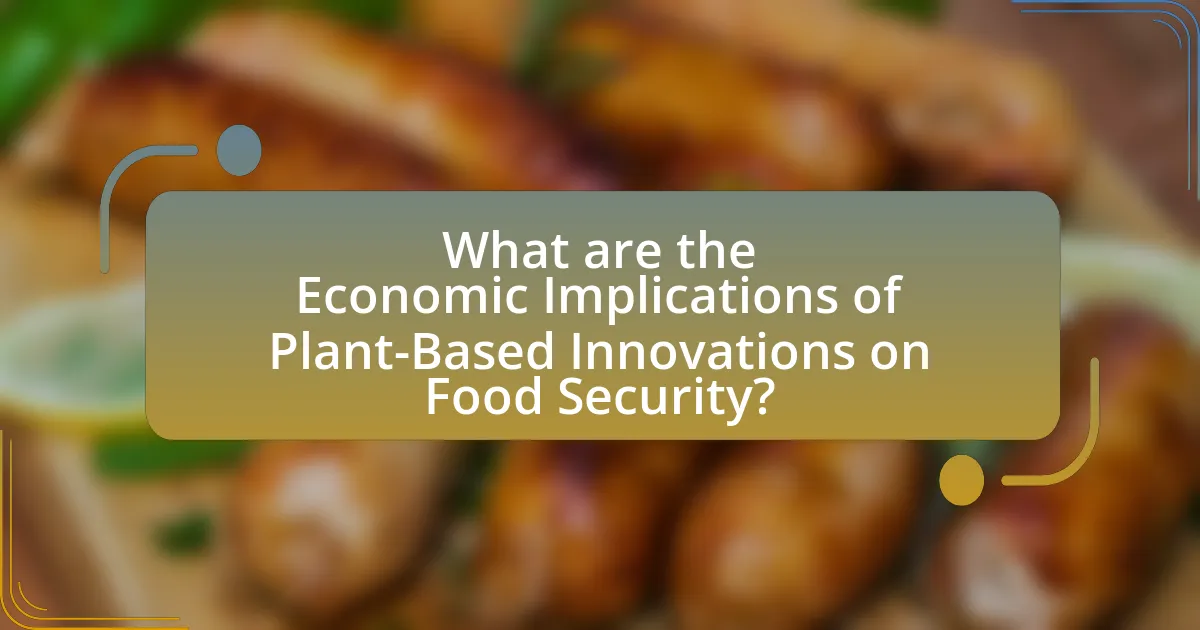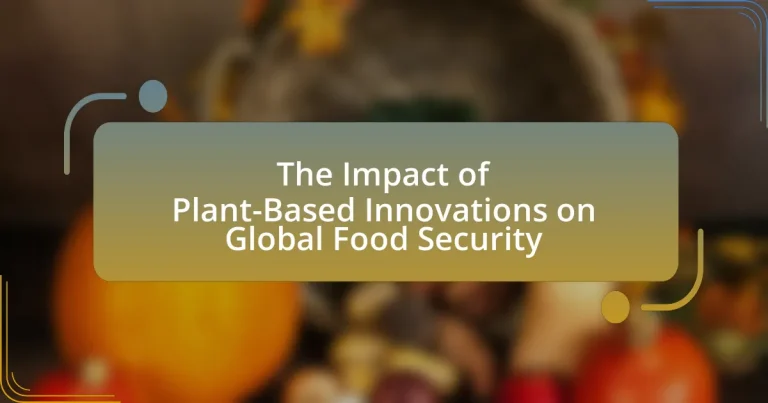Plant-based innovations encompass advancements in food technology and agricultural practices that utilize plant-derived ingredients to enhance food security. These innovations, including lab-grown meat and plant-based protein sources, significantly reduce reliance on animal agriculture, lower greenhouse gas emissions, and improve resource efficiency. The article explores how these technologies contribute to global food security by addressing food scarcity, enhancing accessibility, and promoting sustainable agricultural practices. Additionally, it examines the environmental impacts, economic implications, and challenges associated with the adoption of plant-based innovations, highlighting their potential to reshape food systems and improve nutritional outcomes worldwide.

What are Plant-Based Innovations and Their Role in Food Security?
Plant-based innovations refer to advancements in food technology and agricultural practices that focus on utilizing plant-derived ingredients to create sustainable food products. These innovations play a crucial role in food security by providing alternative protein sources, reducing reliance on animal agriculture, and minimizing environmental impacts. For instance, plant-based proteins can significantly lower greenhouse gas emissions; a study by Poore and Nemecek (2018) in “Science” found that shifting to plant-based diets could reduce food-related emissions by up to 70%. Additionally, plant-based innovations enhance food accessibility and affordability, as they often require fewer resources to produce compared to traditional livestock farming. This shift not only addresses the growing global population’s nutritional needs but also contributes to sustainable agricultural practices, thereby reinforcing food security on a global scale.
How do Plant-Based Innovations contribute to Global Food Security?
Plant-based innovations contribute to global food security by enhancing food production efficiency, reducing environmental impact, and providing sustainable alternatives to animal-based products. These innovations, such as lab-grown meat and plant-based protein sources, can significantly lower resource use; for instance, producing plant-based proteins typically requires less water and land compared to traditional livestock farming. According to a study published in the journal “Nature,” shifting towards plant-based diets could reduce greenhouse gas emissions by up to 70% by 2050, thereby mitigating climate change effects that threaten food supply chains. Furthermore, advancements in agricultural technology, such as vertical farming and precision agriculture, increase crop yields and resilience against pests and climate variability, directly addressing food scarcity issues.
What specific technologies are considered Plant-Based Innovations?
Plant-Based Innovations encompass specific technologies such as precision fermentation, plant-based meat alternatives, and cellular agriculture. Precision fermentation utilizes microorganisms to produce proteins and other ingredients traditionally derived from animals, significantly reducing resource use and emissions. Plant-based meat alternatives, like those developed by companies such as Beyond Meat and Impossible Foods, replicate the taste and texture of meat using plant-derived ingredients, addressing consumer demand for sustainable protein sources. Cellular agriculture involves cultivating animal cells in a lab to create meat products without raising animals, which can potentially lower environmental impacts associated with livestock farming. These technologies collectively contribute to enhancing food security by providing sustainable, nutritious alternatives to conventional animal agriculture.
How do these technologies address food scarcity issues?
Plant-based innovations address food scarcity issues by increasing the efficiency of food production and providing sustainable alternatives to traditional animal agriculture. These technologies, such as lab-grown meat and plant-based protein sources, reduce the environmental impact associated with livestock farming, which is responsible for significant greenhouse gas emissions and land use. For instance, a study published in the journal “Nature” found that adopting plant-based diets could reduce food-related greenhouse gas emissions by up to 70% by 2050. Additionally, these innovations can enhance food security by diversifying food sources and making nutritious options more accessible, particularly in regions facing food shortages.
Why is Food Security a Critical Global Issue?
Food security is a critical global issue because it directly affects the health, stability, and economic well-being of populations worldwide. Approximately 828 million people were estimated to be undernourished in 2021, highlighting the urgent need for sustainable food systems. Food insecurity can lead to malnutrition, increased vulnerability to diseases, and social unrest, as seen in regions experiencing famine or conflict. Furthermore, climate change exacerbates food security challenges by disrupting agricultural production, making it essential to innovate and adapt food systems to ensure access to sufficient, safe, and nutritious food for all.
What are the main challenges facing global food security today?
The main challenges facing global food security today include climate change, population growth, and economic instability. Climate change disrupts agricultural productivity through extreme weather events, affecting crop yields and food availability. According to the Intergovernmental Panel on Climate Change (IPCC), rising temperatures and changing precipitation patterns could reduce global crop yields by up to 30% by 2050. Population growth, projected to reach nearly 10 billion by 2050, increases demand for food, putting additional pressure on already strained resources. Economic instability, exacerbated by conflicts and market fluctuations, leads to food price volatility, making it difficult for vulnerable populations to access sufficient nutrition. These interconnected challenges threaten the stability of food systems worldwide.
How do socio-economic factors influence food security?
Socio-economic factors significantly influence food security by affecting individuals’ access to resources, income levels, and overall economic stability. For instance, lower income levels often correlate with limited access to nutritious food, as individuals may prioritize cheaper, less healthy options due to financial constraints. According to the Food and Agriculture Organization, approximately 690 million people were undernourished in 2019, with poverty being a primary driver of food insecurity. Additionally, education plays a crucial role; individuals with higher educational attainment are more likely to make informed food choices and utilize available resources effectively. Thus, socio-economic factors directly impact food security by shaping the availability, accessibility, and utilization of food resources.

What are the Environmental Impacts of Plant-Based Innovations?
Plant-based innovations significantly reduce environmental impacts by lowering greenhouse gas emissions, conserving water, and preserving biodiversity. For instance, a study published in the journal “Nature” found that shifting to plant-based diets could reduce food-related greenhouse gas emissions by up to 70% by 2050. Additionally, plant-based food production typically requires less water compared to animal agriculture; for example, producing one kilogram of beef requires approximately 15,000 liters of water, whereas producing one kilogram of lentils requires only about 1,500 liters. Furthermore, plant-based innovations contribute to biodiversity preservation by reducing the need for land conversion, which is a major driver of habitat loss. These facts illustrate that plant-based innovations play a crucial role in mitigating environmental degradation and promoting sustainability.
How do Plant-Based Innovations reduce environmental degradation?
Plant-based innovations reduce environmental degradation by minimizing resource consumption and lowering greenhouse gas emissions associated with food production. For instance, plant-based diets require significantly less land and water compared to animal-based diets; research indicates that producing one kilogram of beef requires approximately 15,000 liters of water, while producing one kilogram of lentils requires only about 1,500 liters. Additionally, plant-based food systems contribute to reduced carbon emissions; a study published in the journal “Nature” found that shifting to plant-based diets could reduce global greenhouse gas emissions by up to 70% by 2050. These innovations also promote biodiversity by reducing the need for extensive livestock farming, which often leads to habitat destruction.
What are the benefits of reduced greenhouse gas emissions?
Reduced greenhouse gas emissions lead to improved air quality and enhanced public health. By decreasing pollutants such as carbon dioxide and methane, communities experience fewer respiratory issues and cardiovascular diseases, which are linked to air pollution. According to the World Health Organization, air pollution is responsible for approximately 7 million premature deaths annually, highlighting the direct health benefits of cleaner air resulting from reduced emissions. Furthermore, lower greenhouse gas emissions contribute to climate stability, which is essential for sustainable agriculture and food security, as erratic weather patterns can disrupt food production. Thus, the benefits of reduced greenhouse gas emissions encompass both health improvements and the promotion of a stable environment for food systems.
How do these innovations promote biodiversity?
Plant-based innovations promote biodiversity by enhancing agricultural practices that support diverse ecosystems. These innovations, such as crop rotation, intercropping, and the development of resilient plant varieties, encourage a variety of species to thrive in agricultural settings. For instance, intercropping can increase the number of plant species in a given area, which can lead to improved soil health and reduced pest populations. Research indicates that diverse cropping systems can enhance ecosystem services, such as pollination and nutrient cycling, which are vital for maintaining biodiversity. Additionally, the promotion of native plant species in agricultural systems can help restore habitats and support local wildlife, further contributing to biodiversity.
What role do Plant-Based Innovations play in sustainable agriculture?
Plant-based innovations play a crucial role in sustainable agriculture by enhancing crop yields, reducing environmental impact, and promoting biodiversity. These innovations, such as genetically modified organisms (GMOs), vertical farming, and agroecological practices, enable farmers to produce food more efficiently while minimizing the use of chemical fertilizers and pesticides. For instance, research indicates that GMOs can increase crop resilience to pests and diseases, leading to higher productivity and reduced reliance on harmful chemicals. Additionally, plant-based innovations contribute to soil health and water conservation, essential components of sustainable farming practices. According to a study published in the journal “Nature Sustainability,” adopting these innovations can significantly lower greenhouse gas emissions associated with agriculture, thereby supporting global food security while addressing climate change challenges.
How can these innovations improve soil health?
Innovations such as cover cropping, crop rotation, and the use of biochar can significantly improve soil health by enhancing soil structure, increasing organic matter, and promoting beneficial microbial activity. Cover cropping prevents soil erosion and nutrient leaching, while crop rotation disrupts pest cycles and improves nutrient availability. The application of biochar enhances soil fertility and water retention, leading to healthier crops. Research indicates that these practices can increase soil organic carbon levels by up to 30%, thereby improving overall soil health and productivity.
What practices enhance water conservation through Plant-Based Innovations?
Practices that enhance water conservation through plant-based innovations include the development of drought-resistant crop varieties, the implementation of precision agriculture techniques, and the use of agroecological practices. Drought-resistant crops, such as certain varieties of millet and sorghum, require significantly less water than traditional crops, thereby reducing overall water usage. Precision agriculture employs technology to optimize water application, ensuring that crops receive the exact amount of water needed, which can lead to water savings of up to 30%. Agroecological practices, such as intercropping and cover cropping, improve soil health and moisture retention, further contributing to water conservation. These practices collectively demonstrate how plant-based innovations can effectively address water scarcity while supporting global food security.

What are the Economic Implications of Plant-Based Innovations on Food Security?
Plant-based innovations significantly enhance food security by increasing the efficiency of food production and reducing reliance on resource-intensive animal agriculture. These innovations, such as lab-grown meat and plant-based protein alternatives, can lower production costs and environmental impacts, making food more accessible and sustainable. For instance, a study by the Good Food Institute indicates that plant-based foods require up to 90% less land and water compared to traditional livestock farming, which can alleviate pressure on natural resources and improve food availability. Additionally, the global plant-based food market is projected to reach $74.2 billion by 2027, reflecting a growing consumer demand that can stimulate economic growth and job creation in the sector.
How do Plant-Based Innovations affect food prices?
Plant-based innovations generally lead to a decrease in food prices due to increased efficiency in production and lower resource requirements. For instance, advancements in plant-based protein technologies have resulted in more cost-effective manufacturing processes, which can reduce the overall cost of plant-based products compared to traditional animal-based foods. A study by the Good Food Institute found that the price of plant-based meat alternatives has decreased by 20% over the past five years, making them more accessible to consumers. Additionally, as consumer demand for plant-based options rises, economies of scale can further drive down prices, benefiting both producers and consumers.
What is the impact on farmers’ income and livelihoods?
The impact on farmers’ income and livelihoods is generally positive due to plant-based innovations, which enhance productivity and reduce costs. These innovations, such as improved crop varieties and sustainable farming practices, lead to higher yields and better market access. For instance, a study by the Food and Agriculture Organization (FAO) indicates that adopting climate-resilient crops can increase farmers’ incomes by up to 30% in regions vulnerable to climate change. Additionally, plant-based innovations often reduce dependency on chemical inputs, lowering production costs and increasing profit margins for farmers.
How do these innovations influence market trends in the food industry?
Innovations in plant-based food products significantly influence market trends in the food industry by driving consumer demand for healthier and sustainable options. The rise of plant-based diets has led to a 27% increase in sales of plant-based foods in the U.S. from 2019 to 2020, according to the Plant Based Foods Association. This shift is prompting traditional food companies to expand their product lines to include plant-based alternatives, thereby reshaping market dynamics and increasing competition. Additionally, innovations such as improved taste and texture of plant-based products are attracting a broader consumer base, further accelerating market growth.
What are the potential barriers to adopting Plant-Based Innovations?
The potential barriers to adopting plant-based innovations include consumer resistance, lack of awareness, and insufficient infrastructure. Consumer resistance often stems from cultural preferences and taste perceptions, which can hinder acceptance of plant-based alternatives. A study by the Good Food Institute indicates that 70% of consumers are not familiar with plant-based products, highlighting a significant knowledge gap. Additionally, the current food supply chain may lack the necessary infrastructure to support widespread distribution and production of plant-based foods, limiting accessibility. Economic factors, such as higher costs associated with plant-based ingredients compared to traditional animal products, further complicate adoption. These barriers collectively impede the integration of plant-based innovations into mainstream diets, affecting their potential impact on global food security.
How do cultural perceptions affect the acceptance of Plant-Based foods?
Cultural perceptions significantly influence the acceptance of plant-based foods by shaping dietary norms and values. In cultures where meat consumption is associated with status and tradition, plant-based diets may be viewed as inferior or less desirable. For example, a study published in the journal “Appetite” found that individuals from cultures with strong meat-eating traditions often perceive plant-based diets as lacking in essential nutrients, which can deter acceptance. Conversely, in cultures that prioritize health and sustainability, such as those in parts of Europe and North America, plant-based foods are increasingly embraced as beneficial for both personal health and environmental impact. This shift is supported by research from the “Journal of Consumer Research,” which indicates that positive cultural narratives around plant-based eating can enhance its acceptance and integration into daily diets.
What are the economic challenges faced by producers in implementing these innovations?
Producers face several economic challenges when implementing plant-based innovations, primarily including high initial investment costs, fluctuating market demand, and competition with established animal-based products. High initial investment costs can deter producers from adopting new technologies, as they often require significant capital for research, development, and infrastructure changes. Fluctuating market demand poses a risk, as consumer preferences can shift rapidly, impacting the profitability of plant-based products. Additionally, competition with established animal-based products, which benefit from existing supply chains and consumer familiarity, can make it difficult for plant-based innovations to gain market share. These challenges are supported by industry reports indicating that while the plant-based market is growing, producers still struggle with these economic barriers to entry and sustainability.
What best practices can enhance the impact of Plant-Based Innovations on Food Security?
Implementing sustainable agricultural practices is a best practice that can significantly enhance the impact of plant-based innovations on food security. These practices include crop rotation, agroforestry, and organic farming, which improve soil health and increase biodiversity. For instance, a study published in the journal “Nature Sustainability” found that agroecological practices can increase crop yields by up to 50% while reducing the need for chemical fertilizers and pesticides. Additionally, promoting local food systems and reducing food waste can further strengthen food security by ensuring that plant-based innovations reach communities effectively. According to the Food and Agriculture Organization, reducing food loss and waste could increase food availability by 14% globally, thereby supporting the efficacy of plant-based solutions in addressing food security challenges.


